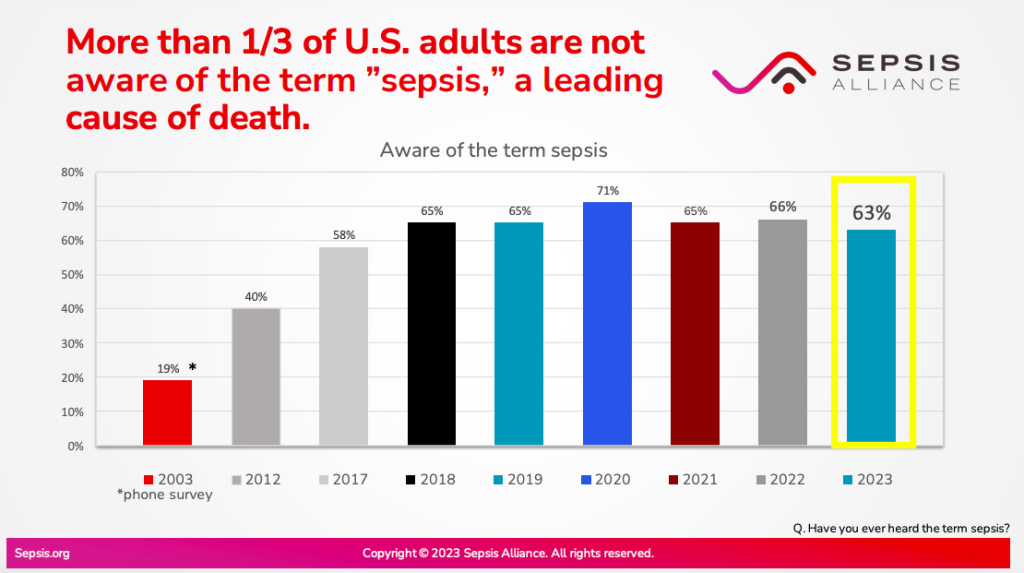Sepsis Alliance Reinforces Call for National Sepsis Action Plan as Awareness of the Term Sepsis Dips to 63%
September 13, 2023
Significant disparities in awareness and symptom knowledge continue to be found related to race, ethnicity, and socioeconomic status.
Sepsis Alliance’s annual awareness survey found that 63% of U.S. adults are aware of the term “sepsis,” down from 66% in 2022. Of those aware of the term sepsis, only 15% were able to identify the four most common symptoms that would lead one to seek emergency care for sepsis, down from 19% in 2022. Due to these stalling numbers, coupled with the mounting economic and human cost of sepsis, Sepsis Alliance is calling for a National Sepsis Action Plan with the potential to raise sepsis awareness and save lives.

Sepsis, the body’s overwhelming and life-threatening response to infection, affects an estimated 49 million people worldwide each year. More than 1.7 million people in the U.S. are diagnosed with sepsis each year and 350,000 of those adults die. Sepsis Alliance, the nation’s first and leading sepsis organization, strives to save lives and reduce suffering by improving sepsis awareness and care through public and healthcare provider education programs, survivor support, and patient advocacy. It is estimated that as many as 80% of septic shock patients can be saved with rapid diagnosis and treatment, emphasizing the need for knowledge and timely recognition of sepsis signs and symptoms.
The annual awareness survey, conducted by YouGov Plc. in 2023, weighs results across the U.S. census for age, gender, race/ethnicity, region, and income. In 2003, the first sepsis awareness survey found 19% of U.S. adults were aware of the term sepsis. As Sepsis Alliance has expanded efforts to educate healthcare professionals, the general public, policymakers, and the media on sepsis, awareness levels have risen, with a peak of 71% awareness in 2020.
Sepsis Alliance has become increasingly aware of disparities in healthcare based on socioeconomic status, race, and other factors. The survey found that those who identify as white are significantly more likely to be aware of the term sepsis (73%) than those who identify as Black (40%) and those who identify as Hispanic (41%), though Black and “other nonwhite” individuals have nearly twice the incidence of sepsis as white individuals. Of those aware of the term sepsis, there was also a significant difference in recognition of the four more common signs and symptoms of sepsis with 26% of those who identify as white recognizing all four, and only 16% of those who identify as Black and 11% of those who identify as Hispanic recognizing temperature, infection, mental decline, and extremely ill as the four more common signs and symptoms of sepsis.
Differences in sepsis awareness levels also vary significantly by self-reported sex, age, income, and education. Those who identify as women are more likely (67%) than those who identify as men (58%) to know the term sepsis. Additionally, those 55 and older are significantly more likely (69%) to recognize the term sepsis than those that are 18 – 34 years old (52%). These differences remain steady year-over-year, with 2022 seeing similar differences. Finally, those with a high school education or less (48%) and those who have an annual household income of less than $40,000 are significantly less likely to know the term sepsis (53%).
The pattern of stalled sepsis awareness levels in U.S. adults over the past three years demonstrates the desperate need for additional education and action. A National Sepsis Action Plan with a focus on reaching medically underserved communities has the potential to save thousands of lives from sepsis each year. As an example, the 2012-2018 TIPS® education campaign featuring “real people from many different backgrounds living with serious long-term health effects from smoking and secondhand smoke exposure,” is estimated to have helped one million people successfully quit smoking. A National Sepsis Action Plan, supported by government agencies, media, and multiple partners, could help make the signs and symptoms of sepsis well known. Knowing the signs and symptoms of sepsis, seeking emergency care, and reaching healthcare professionals with the knowledge to quickly recognize and treat sepsis can save lives – and Sepsis Alliance needs help to make this a reality.
Learn more about Sepsis Alliance’s call for a National Sepsis Action Plan here.
View the entire Sepsis Alliance Annual Awareness Survey report here.
How you can help raise awareness:
- Share your sepsis experience with local media this Sepsis Awareness Month. Find contact information for your local paper and news stations and contact them using information from Sepsis Alliance’s media kit and your own story of survival or loss. Your experience can help others learn the signs, symptoms, and seriousness of sepsis.
- Share sepsis information on social media. Follow Sepsis Alliance on Facebook, Twitter, Instagram, and LinkedIn at @SepsisAlliance and re-share information, to help your network better understand sepsis.
- Visit Sepsis.org. You can learn more about sepsis, Sepsis Alliance, and how to raise further awareness at Sepsis.org.
Methodology:
All figures, unless otherwise stated, are from YouGov Plc. Total sample size was 2,512 US adults. Fieldwork was undertaken between 5th – 7th June 2023. The survey was carried out online. The figures have been weighted and are representative of all US adults (aged 18+).





























